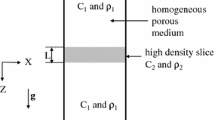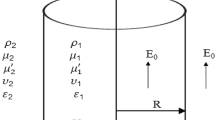Abstract
This study analyzes the stability of an initially sharp interface between two miscible fluids in a porous medium. Linear stability equations are first derived using the similarity variable of the basic state, and then transformed into a system of ordinary differential equations using a spectral expansion with and without quasi-steady-state approximation (QSSA). These transformed equations are solved using the eigenanalysis and initial value problem approach. The initial growth rate analysis shows that initially the system is unconditionally stable. The stability characteristics obtained under the present QSSA are quantitatively same as those obtained without the QSSA. To support these theoretical results, numerical simulations are conducted using the Fourier-spectral method. The results of theoretical linear stability analyses and the numerical simulations validate to each other.















Similar content being viewed by others
Abbreviations
- \(a\) :
-
Dimensionless wavenumber, \(\sqrt{a_x^2 +a_y^2 }\)
- \(a^{*}\) :
-
Modified dimensionless wave number, \(a\sqrt{\tau }\)
- \(C\) :
-
Concentration (M)
- \(c\) :
-
Dimensionless concentration, \({\left( {C-C_+ } \right) }/{\left( {C_{-} -C_+ } \right) }\)
- \(\mathcal{D}\) :
-
Effective diffusion coefficient \(\left( {{\hbox {m}^{2}}/\hbox {s}} \right) \)
- g :
-
Gravitational acceleration vector \(\left( {\hbox {m}/{\hbox {s}^{2}}} \right) \)
- \(K\) :
-
Permeability \(\left( {\hbox {m}^{2}} \right) \)
- \(\mathcal{L}\) :
-
Diffusional operator in \(\left( {\tau ,\zeta } \right) \)-domain, \({\partial ^{2}}/{\partial \zeta ^{2}}+\left( {\zeta /2} \right) \left( {\partial /{\partial \zeta }} \right) \)
- \(P\) :
-
Pressure \(\left( {\hbox {Pa}} \right) \)
- \(t\) :
-
Time \(\left( \hbox {s} \right) \)
- U :
-
Velocity vector \(\left( {\hbox {m}/\hbox {s}} \right) \)
- \(w\) :
-
Dimensionless vertical velocity component
- \(\left( {x,y,z} \right) \) :
-
Dimensionless Cartesian coordinates
- \(\mu \) :
-
Viscosity \(\left( {\hbox {Pa}\, \hbox {s}} \right) \)
- \(\rho \) :
-
Density \(\left( {{\hbox {kg}}/{\hbox {m}^{3}}} \right) \)
- \(\sigma \) :
-
Dimensionless growth rate
- \(\tau \) :
-
Dimensionless time \(\left( {{\mathcal{D}t}/K} \right) \)
- \(\zeta \) :
-
similarity Variable \(\left( {z/{\sqrt{\tau }}} \right) \)
- c:
-
Critical state
- 0:
-
Basic quantity
- 1:
-
Perturbed quantity
References
Ben, Y., Demekhin, E.A., Chang, H.-C.: A spectral theory for small-amplitude miscible fingering. Phys. Fluids 14, 999–1010 (2002)
Boyd, J.P.: Chebyshev and Fourier Spectral Methods. Dover Publications Inc., Mineola (2000)
Caltagirone, J.-P.: Stability of a saturated porous layer subject to a sudden rise in surface temperature: comparison between the linear and energy methods. Q. J. Mech. Appl. Math. 33, 47–58 (1980)
Daniel, D., Tilton, N., Riaz, A.: Optimal perturbations of gravitationally unstable, transient boundary layers in porous media. J. Fluid Mech. 727, 456–487 (2013)
Ennis-King, J., Preston, I., Paterson, L.: Onset of convection in anisotropic porous media subject to a rapid change in boundary conditions. Phys. Fluids 17, 084107 (2005)
Farrel, B.F., Ioannou, P.J.: Generalized stability theory. Part II: Nonautonomous operators. J. Atmos. Sci. 53, 2041–2053 (1996)
Fernandez, J., Kurowski, P., Petitjeans, P., Meiburg, E.: Density-driven unstable flows of miscible fluids in a Hele–Shaw cell. J. Fluid Mech. 451, 239–260 (2002)
Hassanzadeh, H., Pooladi-Darvish, M., Keith, D.W.: Stability of a fluid in a horizontal saturated porous layer: effect of non-linear concentration profile, initial, and boundary conditions. Transp. Porous Med. 65, 193–211 (2006)
Hidalgo, J., Carrera, J.: Effect of dispersion on the onset of convection during \(\text{ CO }_{2}\) sequestration. J. Fluid Mech. 640, 441–452 (2009)
Horton, C.W., Rogers, F.T.: Convection currents in porous medium. J. Appl. Phys. 16, 367–370 (1945)
Kim, M.C.: Onset of radial viscous fingering in a Hele–Shaw cell. Korean J. Chem. Eng. 29, 1688–1694 (2012)
Kim, M.C.: Onset of buoyancy-driven convection in a fluid-saturated porous medium bounded by a long cylinder. Transp Porous Med. 97, 395–408 (2013)
Kim, M.C., Choi, C.K.: The stability of miscible displacement in porous media: nonmonotonic viscosity profiles. Phys. Fluids 23, 084105 (2011)
Kim, M.C., Choi, C.K.: Linear stability analysis on the onset of the buoyancy-driven convection in liquid saturated porous medium. Phys. Fluids 24, 044102 (2012)
Kneafsey, T.K., Pruess, K.: Laboratory experiments and numerical simulation studies of convectively enhanced carbon dioxide dissolution. Energy Procedia 4, 5114–5121 (2011)
Lapwood, E.R.: Convection of a fluid in a porous medium. Proc. Camb. Philos. Soc. 44, 508–521 (1948)
Manickam, O., Homsy, G.M.: Fingering instabilities in vertical miscible displacement flows in porous media. J. Fluid Mech. 288, 75–102 (1995)
Morton, B.R.: On the equilibrium of a stratified layer of fluid. J. Mech. Appl. Math. 10, 433–447 (1957)
Neufeld, J.A., Hesse, M.A., Riaz, A., Hallworth, M.A., Tchelepi, H.A., Huppert, H.E.: Convective dissolution of carbon dioxide in saline aquifers. Geophys. Res. Lett. 37, L22404 (2010)
Pramanik, S., Mishra, M.: Linear stability analysis of Korteweg stresses effect on miscible viscous fingering in porous media. Phys. Fluid 25, 074104 (2013)
Pritchard, D.: The linear stability of double-diffusive miscible rectilinear displacements in Hele–Shaw cell. Eur. J. Mech. B 28, 564–577 (2009)
Rapaka, S., Chen, S., Pawar, R., Stauffer, P.H., Zhang, D.: Non-modal growth of perturbations in density-driven convection in porous media. J. Fluid Mech. 609, 285–303 (2008)
Riaz, A., Hesse, M., Tchelepi, H.A., Orr Jr, F.M.: Onset of convection in a gravitationally unstable, diffusive boundary layer in porous media. J. Fluid Mech. 548, 87–111 (2006)
Rees, D.A.S., Selim, A., Ennis-King, J.P.: The instability of unsteady boundary layers in porous media. In: Vadász, P. (ed.) Emerging Topics in Heat and Mass Transfer in porous media, pp. 85–110. Springer, Berlin (2008a)
Rees, D.A.S., Postelnicu, A., Bassom, A.P.: The linear vortex instability of the near vertical line source plume in porous media. Transp. Porous Med. 74, 211–238 (2008b)
Selim, A., Rees, D.A.S.: The stability of a developing thermal front in a porous medium. I Linear theory. J. Porous Media 10, 1–15 (2007)
Selim, A., Rees, D.A.S.: Linear and nonlinear evolution of isolated disturbances in a growing thermal boundary layer in porous media. AIP Conf. Proc. 1254, 47–52 (2010)
Tan, C.T., Homsy, G.M.: Stability of miscible displacements in porous media: rectilinear flow. Phys. Fluids 29, 3549–3556 (1986)
Taylor, G.I.: The instability of liquid surfaces when accelerated in a direction perpendicular to their planes. Proc. R. Soc. London. A 201, 192–196 (1950)
Trevelyan, P.M.J., Alamarcha, C., de Wit, A.: Buoyancy-driven instabilities of miscible two-layer stratifications in porous media and Hele–Shaw cells. J. Fluid Mech. 670, 38–65 (2011)
Wessel-Berg, D.: On a linear stability problem related to underground \({CO}_{2}\) storage. SIAM J. Appl. Math. 70, 1219–1238 (2009)
Wooding, R.A.: Rayleigh instability of a thermal boundary layer in flow through a porous medium. J. Fluid Mech. 9, 183–192 (1960)
Wooding, R.A.: The stability of an interface between miscible fluids in a porous medium. ZAMP 13, 255–266 (1962)
Acknowledgments
This research was supported by Basic Science Research Program through the National Research Foundation of Korea (NRF) funded by the Ministry of Education, Science and Technology (2012R1A1A2038983). The authors are grateful to all the reviewers for their lucid comments which have served to greatly improve the status of the present article.
Author information
Authors and Affiliations
Corresponding author
Appendices
Appendix 1
The complementary solution of Eq. (3.16) is
Using the properties of definite integral, we have
where \(f\left( \xi \right) =\exp \left( {-a^{*}\xi } \right) \sum _{n=0}^\infty {A_n \left( \tau \right) \phi _n \left( \xi \right) } \). On combining Eqs. (7.1) and (7.2), we can write the complete solution of Eq. (3.16) as
On using the first boundary condition, \(w_1 \rightarrow 0\) as \(\zeta \rightarrow \infty \), into Eq. (7.3) we have
and the second boundary condition,\( w_1 \rightarrow 0\) as \(\zeta \rightarrow \hbox { }-\infty \), gives
In writing Eqs. (7.4) and (7.5), we have used the following results:
where \(a^{*}\) has a finite value. On putting the values of \(B_1\) and \(B_2\) in Eq. (7.3), the solution for \(w_1\) is Eq. (3.17).
Appendix 2
By discretizing Eqs. (3.32), (3.33), and (3.35a) using central difference formulations, we obtained the following relation:
where
Here, \(w_i\) is the vertical velocity disturbance at \(\zeta =\zeta _i\) and \(h\left( {=\zeta _{i+1} -\zeta _i } \right) \) is the fixed step size. We obtained neutral stability condition for a given \(a^{*}\) by finding \(Ra^{*}\) that makes the \(\det \left( \mathbf{G} \right) =0\) under \(\sigma ^{*}=0\).
Rights and permissions
About this article
Cite this article
Kim, M.C., Yadav, D. Linear and Nonlinear Analyses of the Onset of Buoyancy-Induced Instability in an Unbounded Porous Medium Saturated by Miscible Fluids. Transp Porous Med 104, 407–433 (2014). https://doi.org/10.1007/s11242-014-0341-4
Received:
Accepted:
Published:
Issue Date:
DOI: https://doi.org/10.1007/s11242-014-0341-4




